
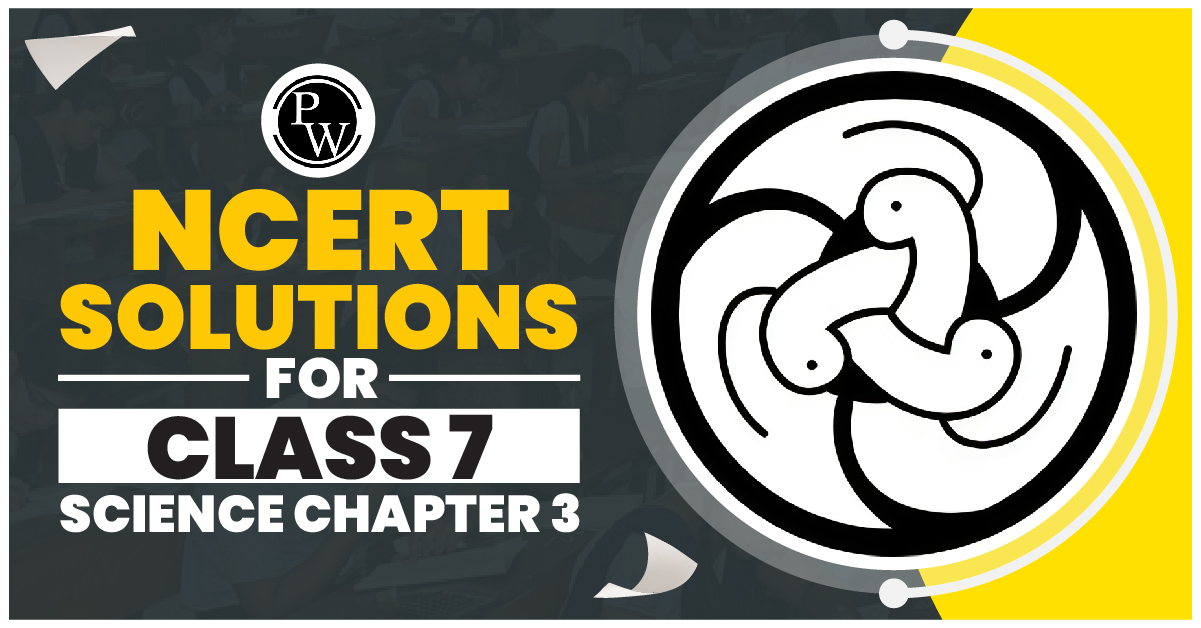
NCERT Solutions for Class 7 Science Chapter 3
NCERT Solutions for Class 7 Science Chapter 3: This page consists of NCERT Solutions Class 7 Science Chapter 3. You can check NCERT Solutions class 7 Science for other chapters of class 7 science prepared by Physics Wallah. do the questions by yourself and check your solution with Physics Wallah NCERT solution for the chapter Fiber to Fabric. to have more depth in chapter Fiber to Fabric class 7 science you must read the theory of Fiber to Fabric and do the additional question of Physics Wallah click this link to do the questions and read theory of Fiber to Fabric. along with NCERT solution of class 7 science.
NCERT Solutions for Class 7 Science Chapter 3 Fibre to Fabric Overview
These crucial subjects are covered in NCERT Solutions Class 7 Science Chapter 3. In order to comprehend the ideas presented in the chapter and make appropriate use of the offered solutions, students are advised to thoroughly read over each topic. The instructors at Physics Wallah have dedicatedly created these solutions to enhance comprehension of the chapter's ideas. The intention is for students to effortlessly achieve high exam scores after reviewing and practicing these solutions.NCERT Solutions for Class 7 Science Chapter 3 Fibre to Fabric
| CBSE Syllabus Class 7 | |
| CBSE Class 7 English Syllabus | CBSE Class 7 Math Syllabus |
| CBSE Class 7 Social Science Syllabus | CBSE Class 7 Science Syllabus |
NCERT Solutions for Class 7 Science Chapter 3 Exercise 1
This chapter 3 comprises of different topics. Like –1. Fibres
2. Types of fibres
3. Silk
4. Wool
5. Sources of wool
How to process wool fibre?
1. Fibres – Fine, long, filaments or continuous threads are acquired for the animals and plants. There are 2 types of fibre. They are – Plant fibre and Animal fibre.
2. Silk – Silk and woollen are the usual fibres obtained from animals. Silk is obtained from the silkworms whilst, wool is obtained from the goat, sheep and yak. Therefore, wool and silk are animal fibres.
3. Animal fibre – Hair of alpaca, llama and camel are handled and processed to produce the wool. Generally, in India, sheep are nurtured and reared for getting the wool. The hair of the sheep is shaved off from the body, cleansed, dried, sorted, colored, gyrated and woven to get the wool.
4. Sources of wool – Wool is acquired from yak (Ladakh and Tibet), Angora goat, sheep, goat, camel, Alpaca etc.,
CBSE Board Exam Centre List 2024
Question 1: You must be familiar with the following nursery rhymes:
(i) ‘Baa baa black sheep, have you any wool.’ (ii) ‘Mary had a little lamb, whose fleece was white as snow.’ Answer the following: (a) Which parts of the black sheep have wool? (b) What is meant by the white fleece of the lamb?Answer: (a) Wool is obtained from the hairy fibres (hair) of the sheep.
(b) White fleece of the lamb refers to the white coloured hair of the lamb.Question 2: The silkworm is (a) a caterpillar, (b) a larva. Choose the correct option.
(i) a (ii) b (iii) both a and b (iv) neither a nor bAnswer: (iii) both a and b
Question 3: Which of the following does not yield wool?
(i) Yak (ii) Camel (iii) Goat (iv) Woolly dogAnswer: (iv)Woolly dog
Question 4: What is meant by the following terms?
(i) Rearing (ii) Shearing (iii) SericultureAnswer: (i) Rearing: It is a process of breeding, feeding and providing medical care to useful animals. These animals are kept since they produce one or more useful products for the human beings.
(ii) Shearing: It is the process of removing fleece from the sheep along with a thin layer of skin. (ii) Sericulture: It is the rearing of silkworms to obtain silk is known as sericulture.Question 5: Given below is a sequence of steps in the processing of wool. Which are the missing steps? Add them.
Shearing, __________, sorting, __________, __________, __________Answer: Shearing, scouring, sorting, picking of burrs, dying of fibres, making of yarn
Question 6: Make sketches of the two stages in the life history of the silk moth which are directly related to the production of silk.
Answer: The two stages in the life history of silk moth directly related to silk production are
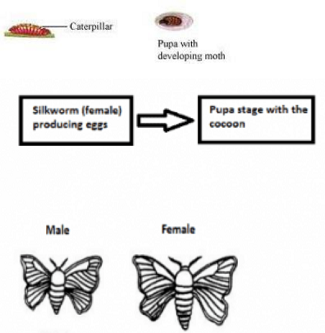
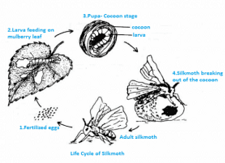
Question 7: Out of the following, which are the two terms related to silk production? Sericulture, floriculture, moriculture, apiculture and silviculture
Hints: (i) Silk production involves cultivation of mulberry leaves and rearing silkworms. (ii) Scientific name of mulberry is Morus alba.Answer: Sericulture and moriculture
Question 8: Match the words of Column I with those given in Column II:
| Column I | Column II |
| (i) Scouring | (a) Yields silk fibres |
| (ii) Mulberry leaves | (b) Wool yielding animal |
| (iii) Yak | (c) Food of silk worm |
| (iv) Cocoon | (d) Reeling |
| (e) Cleaning sheared skin |
Answer:
| Column I | Column II |
| (i) Scouring | (e) Cleaning sheared skin |
| (ii) Mulberry leaves | (c) Food of silk worm |
| (iii) Yak | (b) Wool yielding animal |
| (iv) Cocoon | (a) Yields silk fibres |
Question 9: Given below is a crossword puzzle based on this lesson. Use hints to fill in the blank spaces with letters that complete the words.
Down Across (D) 1: Thorough washing (A) 1: Keeps warm 2: Animal fibre 2: Its leaves are eaten by silkworms 3: Long thread like structure 3: Hatches from egg of moth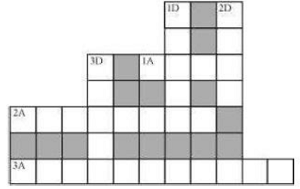
Answer:
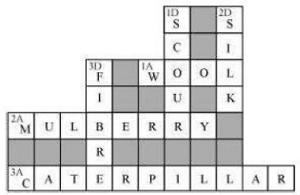 Like Extended Learning—Activity and Projects –
Like Extended Learning—Activity and Projects –
Question 1: Paheli wants to know the maximum length of continuous silk thread that can be obtained from a cocoon.
Find out for her.Answer: 980 metros.
Question 2: Boojho wants to know why caterpillars need to shed their skin when they grow bigger but we humans do not. Do you have any idea?
Answer: During its life-cycle a silkworm undergoes changes in different phases. Caterpillar is one such phase. Next phase is of silk moth which is totally different from caterpillar in shape and size. To go in that phase caterpillar has to shed its skin.
Humans do not undergo such drastic changes during their growth; only size of their body parts change. So, they do not require to shed their skin.Question 3: Boojho wants to know why caterpillars should not be collected with bare hands. Can you help him?
Answer: Because caterpillar’s skin can cause allergy.
Question 4: Paheli wanted to buy a silk frock and went to the market with her mother. There they found that the artificial (synthetic) silk was much cheaper and wanted to know why. Do you know why? Find out.
Answer: The cost of production for artificial silk is very low. The materials used for artificial silk are available in huge quantity. Also, the production time is very less. So, artificial silk is cheaper.
Question 5: Someone told Paheli that an animal called “Vicuna’ also gives wool. Can you tell her where this animal is found? Look for this in a dictionary or an encyclopedia.
Answer: It is found in South America primarily in Central Andes.
NCERT Solutions Class 7 Science Chapter 3 FAQs
What is chapter 3 of science class 7?
What is fleece Class 7?
Is 80% good in 7th grade?
Is there biology in class 7?
Does Class 7 have chemistry?











